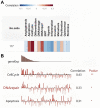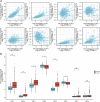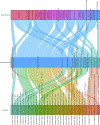Methylation status of TK1 correlated with immune infiltrates in prostate cancer
- PMID: 36035114
- PMCID: PMC9403003
- DOI: 10.3389/fgene.2022.899384
Methylation status of TK1 correlated with immune infiltrates in prostate cancer
Abstract
TK1 is overexpressed in numerous cancers and is associated with to a poor prognosis. However, the relationship between methylation status of TK1 and Immune Infiltrates in Prostate Cancer (PCa) is unknown. The goal of this study was to use comprehensive bioinformatic analyses to elucidate the involvement relationship between methylation status of TK1 and Immune Infiltrates in PCa. TK1 mRNA expression and methylation data in PCa were investigated via GEPIA, TIMER, and UALCAN coupled with MEXPRESS data resources. We employed the LinkedOmics data resource to determine the signaling cascades linked to TK1 expression. Single-cell analysis was performed using the CancerSEA data resource. GeneMANIA and CancerSEA were used to analyze the correlation between TK1 and TK1 coexpressed genes. In addition, TIMER and TISIDB were adopted to assess tumor-invading immune cells and immunomodulators. CTD was utilized to detect the drugs acting on TK1. This study found that TK1 was overexpressed in PCa, and its contents were linked to tumor stage and prognosis. Genes co-expressed with TK1 were enriched in cascades involved in the ribosome, cell cycle, oxidative phosphorylation, DNA replication, oocyte meiosis, and the proteasome. The expression of TK1 along with its methylation status was found to be linked to tumor-invading immune cells, as well as PCa immunomodulators. We also examined the prospect of employing TK1 as a possible target for PCa therapy. This work provides the clinical value of TK1 hypermethylation in PCa and highlights new insights into its novel immunomodulatory functions.
Keywords: DNA methylation; immune infiltrates; prognostic biomarker; prostate cancer; thymidine kinase 1.
Copyright © 2022 Zhang, Ma, Hao, Wang and Sun.
Conflict of interest statement
The authors declare that the research was conducted in the absence of any commercial or financial relationships that could be construed as a potential conflict of interest.
Figures









Similar articles
-
Assessing the Potential Prognostic and Immunological Role of TK1 in Prostate Cancer.Front Genet. 2022 Apr 26;13:778850. doi: 10.3389/fgene.2022.778850. eCollection 2022. Front Genet. 2022. PMID: 35559045 Free PMC article.
-
CD146 as a Prognostic-Related Biomarker in ccRCC Correlating With Immune Infiltrates.Front Oncol. 2021 Dec 8;11:744107. doi: 10.3389/fonc.2021.744107. eCollection 2021. Front Oncol. 2021. PMID: 34956870 Free PMC article.
-
High expression of PDZ-binding kinase is correlated with poor prognosis and immune infiltrates in hepatocellular carcinoma.World J Surg Oncol. 2022 Jan 22;20(1):22. doi: 10.1186/s12957-021-02479-w. World J Surg Oncol. 2022. PMID: 35065633 Free PMC article.
-
Thymidine kinase 1 through the ages: a comprehensive review.Cell Biosci. 2020 Nov 27;10(1):138. doi: 10.1186/s13578-020-00493-1. Cell Biosci. 2020. PMID: 33292474 Free PMC article. Review.
-
Thymidine kinase 1 as a tumor biomarker: technical advances offer new potential to an old biomarker.Biomark Med. 2018 Sep;12(9):1035-1048. doi: 10.2217/bmm-2018-0157. Epub 2018 Jul 24. Biomark Med. 2018. PMID: 30039979 Review.
Cited by
-
Construction and validation of a lysine beta hydroxybutyrylation related molecular model for predicting biochemical recurrence of prostate cancer.Sci Rep. 2025 Aug 5;15(1):28528. doi: 10.1038/s41598-025-12314-x. Sci Rep. 2025. PMID: 40764779 Free PMC article.
-
Thymidine kinase 1 as a target is regulated by the hsa-let-7b-5p/LINC00665 axis and affects NSCLC prognosis.Heliyon. 2023 Oct 28;9(11):e21328. doi: 10.1016/j.heliyon.2023.e21328. eCollection 2023 Nov. Heliyon. 2023. PMID: 37954276 Free PMC article.
-
Predictive levels of vascular endothelial growth factor (VEGF), thymidine kinase 1 (TK1) with interleukin-6 (IL-6), plasma T cells, NK cells as well as B cells in treating diffuse large B-cell lymphoma receiving rituximab.J Med Biochem. 2025 Jul 4;44(4):784-791. doi: 10.5937/jomb0-54911. J Med Biochem. 2025. PMID: 40837360 Free PMC article.
-
Pan-cancer analysis reveals that TK1 promotes tumor progression by mediating cell proliferation and Th2 cell polarization.Cancer Cell Int. 2024 Sep 29;24(1):329. doi: 10.1186/s12935-024-03515-x. Cancer Cell Int. 2024. PMID: 39343871 Free PMC article.
-
Screening tumor stage-specific candidate neoantigens in thyroid adenocarcinoma using integrated exome and transcriptome sequencing.Front Immunol. 2023 Oct 3;14:1187160. doi: 10.3389/fimmu.2023.1187160. eCollection 2023. Front Immunol. 2023. PMID: 37854594 Free PMC article.
References
LinkOut - more resources
Full Text Sources

